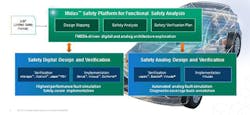Safety Solution Speeds Certification of Automotive Designs
What you'll learn:
- What is FMEDA?
- What tools are included in Cadence's Midas platform?
Development of safety-compliant semiconductors is critical to the connectivity and autonomy of electronics in the automotive industry. At the center of a new safety solution from Cadence is a tool called Midas, which integrates natively within the Cadence flow from design to verification.
Midas offers complete failure modes, effects, and diagnostic analysis (FMEDA) management for ISO 26262 certification. It targets safety-critical applications and features integrated analog and digital safety flows and engines for faster ISO 26262 and IEC 61508 certification. ISO 26262 is a derivative of IEC 61508, which specifies similar requirements for industries other than automotive. This all falls under the umbrella of building dependable SoCs and systems.
The solution includes a new offering that allows users to perform FMEDA-driven analog and digital verification of safety-critical semiconductors for automotive, industrial, and aerospace applications.
Other verification tools included in the Cadence Safety Solution include the Midas vManager Safety Manager and Xcelium Safety Simulator. The safety flows provide automotive, industrial, and aerospace users with integrated safety analysis, fault campaign management, and execution capabilities.
A FMEDA plan in Midas can drive a comprehensive fault campaign in a Cadence-based verification flow. It includes concurrent fault simulation in Xcelium Logic Simulation, formal fault reachability in the Jasper formal verification tool, automated safety mechanism insertion in the register-transfer-level (RTL) synthesis and physical synthesis engine Genus, and analog defect analysis with advanced aging in the Legato reliability solution.
“Semiconductor development for automotive applications presents a host of challenges that the entire supply chain needs to address, including rigorous safety certifications required to achieve compliance with the ISO 26262 standard,” said Paul Cunningham, corporate vice president and general manager of the System & Verification Group at Cadence. With the Cadence Safety Solution, engineers can perform early estimations of the safety metrics based on a predecessor design, enabling proper planning for safety mechanisms.
What’s in the FMEDA-Driven Midas Platform?
Let’s take a closer look at the elements which comprise the Cadence solution:
FMEDA Management via the Midas Safety Platform provides early phase exploration of functional-safety architectures and leverages native chip design data to perform accurate safety analysis. The platform is a unified solution available across Cadence products, and with a modular architecture, supports both embedded or standalone usage with the Cadence flow.
The Xcelium Safety Simulator leverages Cadence’s native serial and concurrent fault-simulation technologies for safety analysis. The simulator’s machine-learning algorithms, coupled with the formal-based flow, accelerate the overall verification throughput.
The vManager Safety Manager offers functional-safety verification management integrated in one system across all Cadence engines. Cadence claims a 3X turnaround time reduction for safety verification campaigns by leveraging vManager Safety Manager to orchestrate fault coverage across the Jasper FSV App and Xcelium Safety Simulator. The Jasper FSV App applies formal techniques to fault analysis, reducing a simulation fault list by up to 30%, according to Cadence, increasing safety verification performance.
In addition, the vManager Verification Management platform enables requirements traceability, while vManager Safety Manager handles safety verification in both analog and digital domains and automates reporting for required safety documentation.
As Franck Roche, architecture, technical support, application, and tools director, Microcontroller Division at STMicroelectronics, noted in the Cadence press materials, “Simulating random faults in functional-safety verification is a big challenge in industrial applications. Modeling the diverse nature of safety mechanisms adds significant complexity and requires reliable and flexible simulation tools. In providing flow automation, turnaround time optimization, and quality of results, the new Cadence Safety Solution extends the existing Cadence Verification Suite and helps us achieve faster IEC 61508 certification.”
The Safety Solution further integrates the Spectre Simulation Platform and the Legato Reliability Solution to allow for automated launching of analog and mixed-signal fault simulations for different failure modes. It also generates functional-safety diagnostic coverage reports with an annotation back into the Midas Safety Platform, accelerating functional-safety closure. The Cadence Legato Reliability Solution can be used to perform fault injection into analog designs and run simulations, and then incorporate the results into safety metrics.
The Safety Solution also integrates the Genus Synthesis Solution, the physical implementation tool Innovus, and Cadence’s Conformal Equivalence Checker to guide the insertion of safety mechanisms in the implementation flow. This allows users to achieve safety requirements while optimizing for power, performance, and area objectives.
"As automation advances in functional safety, the role of standardization from groups like Accellera Systems Initiative and IEEE becomes important," said Alessandra Nardi, senior engineering group director at Cadence. "The Accellera Functional Safety Working Group is defining a standard language to capture and exchange functional-safety data that will significantly benefit interoperability and traceability. Cadence is contributing to the Accellera Functional Safety Working Group and supports the IEEE P2851 efforts to continue the development of these standards."
Overall, Cadence’s Safety Solution supports the company’s Intelligent System Design strategy, targeted at enabling SoC design excellence. The solution has been several years in the making, spans Cadence’s full flow, and goes beyond Cadence to supporting an ecosystem with a new unified safety format for multi-vendor tool interoperability in functional safety.


